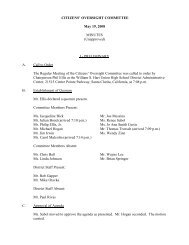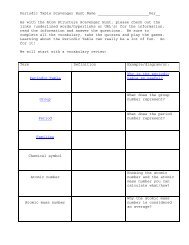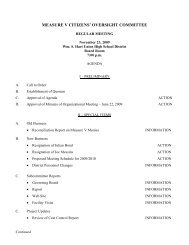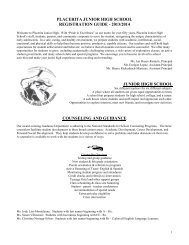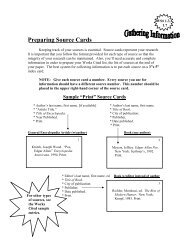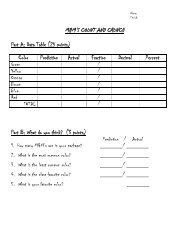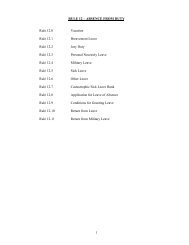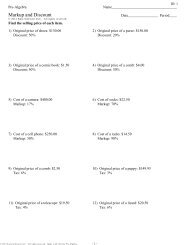Safe School Plan - William S. Hart Union High School District
Safe School Plan - William S. Hart Union High School District
Safe School Plan - William S. Hart Union High School District
Create successful ePaper yourself
Turn your PDF publications into a flip-book with our unique Google optimized e-Paper software.
Asthma, derived from the ancient Greek word for panting, is a chronic condition in which the airways temporarily become impeded, causing<br />
labored breathing, wheezing or coughing. During an asthma attack, the muscles tighten around the airways, constricting the free exchange of<br />
air. The lining of the airways becomes inflamed and swollen. Children’s airways are narrower than those of adults, thus irritation that would<br />
produce only a<br />
slight response in an adult can result in significant obstruction in the airways of a young child. Older people with asthma experience higher<br />
mortality rates from asthma than other age groups.<br />
Individuals with cardiovascular disease: Cardiovascular diseases include many ailments, such as hardening of the arteries, high blood<br />
pressure, angina pectoris, heart attacks and strokes. It is the leading cause of death in the United States, responsible for about 42% of all<br />
deaths each year. The vast majority of those deaths are in people over the age of 65. Studies have linked particulate pollution to increased<br />
heart attacks and symptoms in those with cardiovascular disease. The exact toxicological mechanisms are not well understood, but studies<br />
show that particulate matter causes respiratory symptoms, changes in lung function, alteration of mucociliary clearance and pulmonary<br />
inflammation that can lead to increased permeability of the lungs. This, in turn, can cause fluid to accumulate in the lungs. Mediators released<br />
during an inflammatory response could increase the risk of blood clot formation and strokes. Other studies have shown that the particles may<br />
trigger certain neurons in the respiratory tract, leading to effects on the nervous system.<br />
The elderly: Studies estimate that tens of thousands of elderly people die prematurely each year from exposure to particulate pollution. Part<br />
of that is due to the fact that the elderly are more likely to have pre-existing lung and heart diseases. In addition, the elderly seem to be more<br />
affected than other age groups because we lose important respiratory defense mechanisms as we age. Older individuals tend to have more<br />
difficulty clearing particles from their lungs. As a result, pollutants to irritate the lungs for longer periods of time and can cause more damage.<br />
In addition, particulate pollution can compromise the immune system, increasing the susceptibility to bacterial or viral respiratory infections.<br />
This can lead to an increase incidence of pneumonia and other complications among the elderly.<br />
Children: Children, even those without any preexisting conditions, are considered a sensitive population because their lungs are still<br />
developing, making them more susceptible to environmental threats than healthy adults. Several factors lead to increased exposure in<br />
children: compared to adults, they tend to spend more time outside; they engage in about three times the vigorous activity, and they breathe<br />
about 50% more air per pound of body weight. Studies have shown that particulate pollution is associated with increased respiratory<br />
symptoms and decreased lung function in children, including symptoms such as aggravated coughing and difficulty or pain in breathing.<br />
These can result in school absences and limitation in normal childhood activities.<br />
Smokers: People who smoke have already compromised their lung function. Exposure to high levels of particulate can exacerbate their<br />
condition, leading to chest pain, trouble breathing and other respiratory symptoms more quickly than in non-smokers. As a way to put<br />
smoking in context, in a 10’ by 13’ room with an 8’ ceiling, it takes only 10 minutes for the side stream smoke of 4 cigarettes to create<br />
3<br />
ambient levels of particulate in the hazardous ranges (644 ug/m ) 3<br />
Characteristics of smoke<br />
The behavior of smoke depends on many factors, including the fire’s size, the fire’s location, the topography of the area and the weather. In<br />
mountainous terrain, where inversions are common, smoke often fills the valleys, where, incidentally, people usually live. Smoke levels can<br />
be very hard to predict: a wind that usually clears out a valley, may simply blow more smoke in, or may fan the fires causing a worse episode<br />
the next day. Smoke concentrations tend to change constantly. (By the time you issue a warning, the smoke may have cleared out.) National<br />
Weather Service satellite photos, weather and wind forecasts, and knowledge of the area can all help in predicting how much smoke will<br />
come into an area, but predictions are rarely accurate for more than a few hours out. The National Weather Service’s website has a lot of<br />
information, including satellite photos that are updated throughout the day. For the western United States, the web address is<br />
www.wrh.noaa.gov.<br />
Judging particulate levels in smoke<br />
Communities that have established air quality programs and alert systems traditionally base their advisements to the public on the 24 or 8<br />
hour averages of particulate. However, it makes sense to approach smoke emergencies differently, for a couple of reasons. Smoke<br />
concentrations tend to be very high for a few hours, and then drop off dramatically. But, research has shown that the spikes may be what<br />
cause some of the most deleterious effects. In addition, the particulate from smoke is very small, and has more of an impact than PM 10<br />
, which<br />
is what most emergency plans are based upon. Another factor is public perception. Since smoke is such a good scatterer of light, visibility<br />
changes drastically as smoke concentrations increase. Even without being told, the public can tell when the smoke is getting worse, and they<br />
want authorities to respond to those changes as they are happening, instead of when they have been going on for eight hours, or when they are<br />
over.<br />
66





